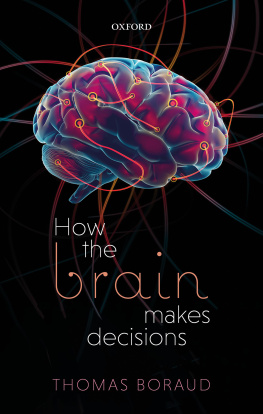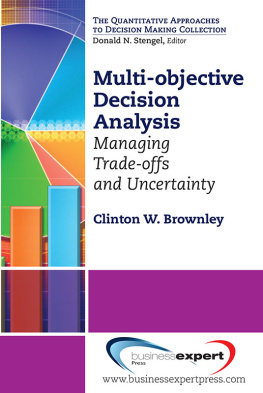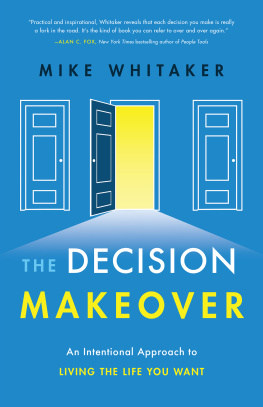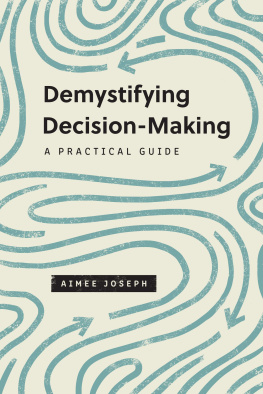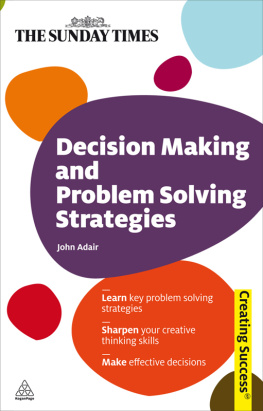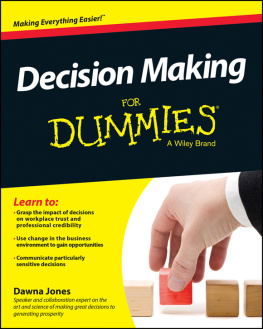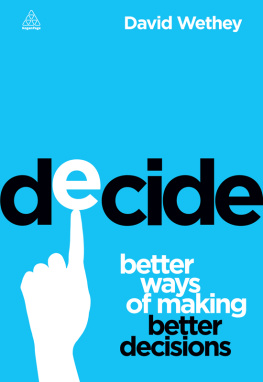How the Brain Makes Decisions

Great Clarendon Street, Oxford, OX2 6DP,
United Kingdom
Oxford University Press is a department of the University of Oxford. It furthers the Universitys objective of excellence in research, scholarship, and education by publishing worldwide. Oxford is a registered trade mark of
Oxford University Press in the UK and in certain other countries
Oxford University Press 2020
The moral rights of the author have been asserted First Edition published in 2020
Impression: 1
All rights reserved. No part of this publication may be reproduced, stored in a retrieval system, or transmitted, in any form or by any means, without the prior permission in writing of Oxford University Press, or as expressly permitted by law, by licence or under terms agreed with the appropriate reprographics rights organization. Enquiries concerning reproduction outside the scope of the above should be sent to the Rights Department, Oxford University Press, at the address above
You must not circulate this work in any other form and you must impose this same condition on any acquirer
Published in the United States of America by Oxford University Press
198 Madison Avenue, New York, NY 10016, United States of America
British Library Cataloguing in Publication Data
Data available
Library of Congress Control Number: 2020935775
ISBN 9780198824367
eISBN 9780192557766
Oxford University Press makes no representation, express or implied, that the drug dosages in this book are correct. Readers must therefore always check the product information and clinical procedures with the most up-to-date published product information and data sheets provided by the manufacturers and the most recent codes of conduct and safety regulations. The authors and the publishers do not accept responsibility or legal liability for any errors in the text or for the misuse or misapplication of material in this work. Except where otherwise stated, drug dosages and recommendations are for the non-pregnant adult who is not breast-feeding
Links to third party websites are provided by Oxford in good faith and for information only. Oxford disclaims any responsibility for the materials contained in any third party website referenced in this work.
Contents
Fifty Shades of Grey Matter was, for the sake of witticism, my first choice of title for the English version of this book. It would have been probably better for the press coverage, but it would also have necessitated a twist to the original take-home message. I was considering insisting on the dynamic properties of the brain as a driver of the decision-making process, and how each decision consists of switching from one brain state to the other. Each shade would have corresponded to a brain state and I would have emphasized how aberrant some of those states could be. Unfortunately, even though this argument would have fitted perfectly with the title, I quickly realized that this new orientation was artificial and did not provide a faithful enough rendition of the French version of my essay. So, in lieu of my tentative attempts to be appealing to wide press coverage, I switched to the more straightforward title, How the Brain Makes Decisions.
There are many good books about decision-making that have been published up to now, so why create a new one? The answer to this lies indeed in the title. This book is the first attempt to tackle the neurobiology of decision-making from a bottom-up perspective. I invite the reader on a journey into time, in order to understand from what neural substrate the decision-making structure evolved in vertebrates and how much it impacts on the way we perform decision-making. Therefore, we start from the neural matter and try to understand how decision-making emerged from the physicochemical interactions between its components. This approach is innovative when compared to the traditional view of experimental psychology in which a theoretical principle is enforced into a neural structure using a top-down epistemology.
The French edition was published in 2015 and received honourable press coverage. The distribution and feedback from readers and colleagues allowed me to think that this venture was worthwhile. The text was then re-published in a pocket version. This English edition has allowed me to update my original theory (some predictions I made then have been confirmed since) and correct some errors and approximations (some of which were highlighted by scrupulous readers). I have also updated the historical background (the reader will understand soon that my interest in science is balanced by my interest in history). I rewrote entirely (instead of translating) several chapters, especially the chapters covering pathophysiology, which were too nave. The revised chapters may still be perceived as nave perhaps, but I endorse them, and that is not the case anymore for some of my former hypothesis. I have also added a new full chapter about free will. This resulted from discussions, debates and round tables I have participated in since the publication of the original text.

